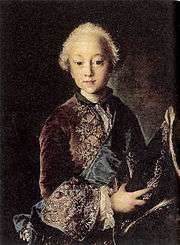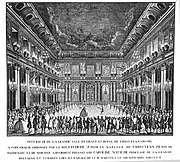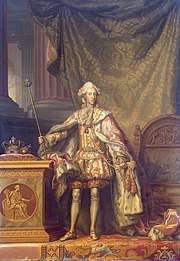Christian VII of Denmark
Christian VII (29 January 1749 – 13 March 1808) was a monarch of the House of Oldenburg who was King of Denmark–Norway and Duke of Schleswig and Holstein from 1766 until his death in 1808. For his motto he chose: "Gloria ex amore patriae" ("glory through love of the fatherland").[1]
| Christian VII | |
|---|---|
 | |
| King of Denmark and Norway (more...) | |
| Reign | 14 January 1766 – 13 March 1808 |
| Coronation | 1 May 1767 Christiansborg Palace Chapel |
| Predecessor | Frederick V |
| Successor | Frederick VI |
| Born | 29 January 1749 Christiansborg Palace, Copenhagen |
| Died | 13 March 1808 (aged 59) Rendsburg |
| Burial | |
| Spouse | |
| Issue | Frederick VI of Denmark Louise Auguste, Duchess of Schleswig-Holstein-Sonderburg-Augustenburg |
| House | Oldenburg |
| Father | Frederick V of Denmark |
| Mother | Louise of Great Britain |
| Religion | Lutheran |
Christian VII's reign was marked by mental illness and for most of his reign Christian was only nominally king. His half-brother Frederick was designated as regent of Denmark in 1772. From 1784 until Christian VII's death in 1808, Christian's son, later Frederick VI, acted as unofficial regent.[2]
Early life

Christian was the son of King Frederick V and his first wife Louise of Great Britain. He was born in the Queen's Bedchamber at Christiansborg Palace, the royal residence in Copenhagen. He was baptized a few hours later the same day. His godparents were King Frederick V (his father), Queen Dowager Sophie Magdalene (his paternal grandmother), Princess Louise (his aunt) and Princess Charlotte Amalie (his grand-aunt).[3]
A former heir to the throne, also named Christian, had died in infancy in 1747; therefore, hopes were high for the future of the new heir apparent. Christoph Willibald Gluck, then conductor of the royal opera troupe, composed the opera La Contesa dei Numi ("The Contention of the Gods"), in which the Olympian Gods gather at the banks of the Great Belt and discuss who in particular should protect the new prince. His mother Queen Louise died in 1751, two years after his birth. The following year his father married Duchess Juliana Maria of Brunswick-Wolfenbüttel.[4]
Early historians state that he had a winning personality and considerable talent, but that he was poorly educated and systematically terrorized by a brutal tutor, Christian Ditlev Frederik Reventlow, the Count of Reventlow. He seems to have been intelligent and had periods of clarity, but suffered from severe emotional problems, possibly schizophrenia, as argued by Doctor Viggo Christiansen in Christian VII's mental illness (1906).
Reign
After a long period of infirmity, Frederick V died on 14 January 1766, just 42 years old. Later the same day, Christian was proclaimed king from the balcony of Christiansborg Palace, weeks before his 17th birthday. Christian's reign was marked by mental illness[5] which affected government decisions, and for most of his reign Christian was only nominally king. His court physicians were especially worried by his frequent masturbation.[6] His royal advisers changed depending on who won power struggles around the throne. In the late 1760s, he came under the influence of his personal physician Johann Friedrich Struensee, who rose steadily in power. From 1770 to 1772, Struensee was de facto regent of the country, and introduced progressive reforms signed into law by Christian VII. Struensee was deposed by a coup in 1772 after which the country was ruled by Christian's stepmother, Juliane Marie of Brunswick-Wolfenbüttel, his half-brother Frederick and the Danish politician Ove Høegh-Guldberg.[7]
Marriage

The young King was betrothed to his fifteen-year-old cousin Princess Caroline Matilda, sister of George III of the United Kingdom, who was anxious about the marriage but not aware that the bridegroom was mentally ill. The dynastic marriage took place at Christiansborg Palace on 8 November 1766. After his marriage, he abandoned himself to the worst excesses, especially sexual promiscuity. In 1767, he entered into a relationship with the courtesan Støvlet-Cathrine. He ultimately sank into a condition of mental stupor. Symptoms during this time included paranoia, self-mutilation and hallucinations.[8]
Struensee

The progressive and radical thinker Johann Friedrich Struensee, Christian's personal physician, became his advisor and rose steadily in power in the late 1760s to de facto regent of the country, where he introduced widespread progressive reforms. Struensee was a protégé of an Enlightenment circle of aristocrats that had been rejected by the court in Copenhagen. He was a skilled doctor, and having somewhat restored the king's health while visiting the Schleswig-Holstein area, he gained the king's affection. He was retained as travelling physician (Livmedikus hos Kong Christian VII) on 5 April 1768, and accompanied the entourage on the King’s foreign tour to Paris and London via Hannover from 6 May 1768 to 12 January 1769. He was given the title of State Councilor (etatsråd) on 12 May 1768, barely a week after leaving Altona. The neglected and lonely Caroline Matilda entered into an affair with Struensee.[9]
Divorce
In 1772, the king's marriage with Caroline Matilda was dissolved by divorce. Christian's marriage with Caroline Matilda produced two children: the future King Frederick VI and Princess Louise Auguste. However, it is widely believed that Louise was the daughter of Struensee—portrait comparisons tend to support this hypothesis. Struensee, who had enacted many modernising and emancipating reforms, was arrested and executed the same year. Christian signed Struensee's arrest and execution warrant under pressure from his stepmother, Queen Juliane Marie, who had led the movement to have the marriage ended. Caroline Matilda, retaining her title but not her children, eventually left Denmark, and passed her remaining days in exile at Celle Castle in her brother's German territory, the Electorate of Hanover. She died there of scarlet fever on 10 May 1775, at the age of 23.[10]
Later life
Christian was only nominally king from 1772 onward. Between 1772 and 1784, Denmark-Norway was ruled by his stepmother, the Queen Dowager Juliane Marie, his half-brother Frederick, and the Danish politician Ove Høegh-Guldberg. From 1784, his son Frederick VI ruled permanently as prince regent. This regency was marked by liberal and agricultural reforms, but also by the beginning of the disasters of the Napoleonic Wars.
Death and succession

Christian died at age 59 of a stroke on 13 March 1808 in Rendsburg, Schleswig. Although there were rumors that the stroke was caused by fright at the sight of Spanish auxiliary troops, which he took to be hostile, Ulrik Langen, in his biography of the king, did not indicate that there was any external cause. He was buried in Roskilde Cathedral and was succeeded by his son Frederick VI.[11]
Legacy
Contribution to science
In 1769 Christian VII of Denmark invited the Hungarian astronomer Miksa Hell (Maximilian Hell) to Vardø. Hell observed the transit of Venus, and his calculations gave the most precise calculation of the Earth–Sun distance to that date (approx. 151 million kilometres). Hell's companion János Sajnovics explored the affinity among the languages of the Sami, Finnish, and Hungarian peoples (all members of the Finno-Ugric language family).[12][13][14]
Cultural depictions
Christian VII, the story of his marriage, and his wife's affair with Struensee has featured in many artistic works:
Literature
- von Hollander-Lossow, Else (1935) - Die Gefangene von Celle
- Neumann, Robert (1935) - German: Struensee: Doktor, Diktator, Favorit und armer Sünder; later Der Favorit der Königin ("The Favourite of the Queen")
- Maass, Edgar (1948) - The Queen's Physician
- Blixen, Karen (1953) - Danish: Samtale om natten i København ("Converse at Night in Copenhagen")
- Lofts, Norah (1969) - The Lost Queen
- Enquist, Per Olov (1999) - Swedish: Livläkarens besök ("The Visit of the Royal Physician")
- Steensen-Leth, Bodil (2000) - Prinsesse af Blodet - en roman om Caroline Mathilde
- Fo, Dario (2015) - C'è un re pazzo in Danimarca
Stage
- Struensee - an 1827 drama by Michael Beer with stage music by his brother Giacomo Meyerbeer.
- Caroline Mathilde - a 1991 two-act ballet staged by the Royal Danish Ballet and choreographed by Flemming Flindt to music by Sir Peter Maxwell Davies.
- The Visit of the Royal Physician (Danish: Livlægens besøg) - a 2008 opera staged by the Royal Danish Opera and composed by Bo Holten to a libretto based on Enquist's 1999 novel.
Film
- The Love of a Queen - a 1923 German silent film directed by Ludwig Wolff, in which Christian VII is played by Walter Janssen.
- The Dictator - a 1935 British film, in which Christian VII was played by Emlyn Williams. The film depicts his relationship with Caroline Mathilde, who is played by Madeleine Carroll.
- King in Shadow (German: Herrscher ohne Krone) - a 1957 West German film based on Neumann's 1935 novel, in which Christian VII was played by Horst Buchholz.
- Caroline - den sidste rejse - a 2010 Danish film
- A Royal Affair (Danish: En Kongelig Affære) - a 2012 Academy Award-nominated film in which King Christian is played by Mikkel Følsgaard.
Titles and styles
- 29 January 1749 – 14 January 1766: His Royal Highness The Crown Prince
- 14 January 1766 – 13 March 1808: His Majesty The King
The full title of Christian VII was: By the Grace of God, King of Denmark and Norway, the Wends, and the Goths, Duke of Schleswig, Holstein, Stormarn, and Dithmarschen, Count of Oldenburg and Delmenhorst. Oldenburg was elevated to a duchy during his reign, and the style was changed accordingly: By the Grace of God, King of Denmark and Norway, the Wends, and the Goths, Duke of Schleswig, Holstein, Stormarn, Dithmarschen, and Oldenburg. This style was used until his son, Frederick VI, lost control over Norway by the 1814 Treaty of Kiel.
Ancestry
| Ancestors of Christian VII of Denmark[15] | |||||||||||||||||||||||||||||||||||||||||||||||||||||||||||||||||||||||||||||||||||||||||||||||||||||||||||||||||||||||||||||||||||||||||||||||||||||||||||||||||||||||||||||||||||||||||||||||||||||||||||||||||||||||||||||||||||||||||||||||||||||||||||||||||||||||||||||||||||||||||
|---|---|---|---|---|---|---|---|---|---|---|---|---|---|---|---|---|---|---|---|---|---|---|---|---|---|---|---|---|---|---|---|---|---|---|---|---|---|---|---|---|---|---|---|---|---|---|---|---|---|---|---|---|---|---|---|---|---|---|---|---|---|---|---|---|---|---|---|---|---|---|---|---|---|---|---|---|---|---|---|---|---|---|---|---|---|---|---|---|---|---|---|---|---|---|---|---|---|---|---|---|---|---|---|---|---|---|---|---|---|---|---|---|---|---|---|---|---|---|---|---|---|---|---|---|---|---|---|---|---|---|---|---|---|---|---|---|---|---|---|---|---|---|---|---|---|---|---|---|---|---|---|---|---|---|---|---|---|---|---|---|---|---|---|---|---|---|---|---|---|---|---|---|---|---|---|---|---|---|---|---|---|---|---|---|---|---|---|---|---|---|---|---|---|---|---|---|---|---|---|---|---|---|---|---|---|---|---|---|---|---|---|---|---|---|---|---|---|---|---|---|---|---|---|---|---|---|---|---|---|---|---|---|---|---|---|---|---|---|---|---|---|---|---|---|---|---|---|---|---|---|---|---|---|---|---|---|---|---|---|---|---|---|---|---|---|---|---|---|---|---|---|---|---|---|---|---|---|---|---|---|---|
| |||||||||||||||||||||||||||||||||||||||||||||||||||||||||||||||||||||||||||||||||||||||||||||||||||||||||||||||||||||||||||||||||||||||||||||||||||||||||||||||||||||||||||||||||||||||||||||||||||||||||||||||||||||||||||||||||||||||||||||||||||||||||||||||||||||||||||||||||||||||||
References
- Magne Njåstad. "Christian 7". Store norske leksikon. Retrieved 15 August 2016.
- "Frederik the Heir Presumptive". kongernessamling. Retrieved 15 August 2016.
- "Kongelig fødsel og dåb - om kirkebøgerne - fra Dansk Historisk Fællesråd" (in Danish). historie-online.dk. Retrieved 18 February 2013.
- "Charlottenborg - et stop på din musikalske byvandring gennem København" (in Danish). The Royal Danish Library. Archived from the original on 15 September 2011. Retrieved 16 February 2013.
- Jan Sjåvik. The A to Z of Norway p.49
- Ihalainen, Pasi (2011). Scandinavia in the age of revolution Nordic political cultures, 1740-1820. Farnham, Surrey, England Burlington, Vt: Ashgate. pp. 73, 74. ISBN 0754698661.
- Terje Bratberg. "Christian 7". Norsk biografisk leksikon. Retrieved 15 August 2016.
- Magne Njåstad. "Caroline Mathilde". Norsk biografisk leksikon. Retrieved 15 August 2016.
- Magne Njåstad. "Johann Friedrich Struensee". Norsk biografisk leksikon. Retrieved 15 August 2016.
- Arvid Bornstein. "Celle". Norsk biografisk leksikon. Retrieved 15 August 2016.
- Ulrik Langen, 2008, s. 485ff
- Kragh, Helge (2008). The Moon that Wasn't: The Saga of Venus' Spurious Satellite. Springer. p. 199. ISBN 3-7643-8908-7, ISBN 978-3-7643-8908-6.
- Jacek Juliusz Jadacki, Witold Strawiński, Jerzy Pelc. In the World of Signs: Essays in Honour of Professor Jerzy Pelc, Rodopi: 1998, p. 459. ISBN 90-420-0389-8, ISBN 978-90-420-0389-7.
- Mikko Korhonen. Finno-Ugrian Language Studies in Finland, 1828–1918, Societas Scientiarum Fennica, 1986. p. 226. ISBN 951-653-135-0, ISBN 978-951-653-135-2.
- Genealogie ascendante jusqu'au quatrieme degre inclusivement de tous les Rois et Princes de maisons souveraines de l'Europe actuellement vivans [Genealogy up to the fourth degree inclusive of all the Kings and Princes of sovereign houses of Europe currently living] (in French). Bourdeaux: Frederic Guillaume Birnstiel. 1768. p. 6.
Bibliography
- Reddaway, W. F. "King Christian VII," English Historical Review (1916) 31#121 pp. 59–84 IN jstor
- Sjåvik, Jan (2010) The A to Z of Norway (Scarecrow Press) ISBN 978-0810872134
In Danish
- Alenius, Marianne (ed.) Mit ubetydelige Levnets Løb. Efter Charlotte Dorothea Biehls breve. Museum Tusculanums Forlag, Copenhagen 1986
- Barz, Paul. Doktor Struensee. Bogans Forlag, Lynge, 1986
- Bech, Svend Cedergreen. Brev fra Dorothea. Politikens Forlag, Copenhagen 1975
- Christiansen, Viggo. Christian den VII's sindssygdom. Odense Universitetsforlag, 1978
- Dehn-Nielsen, Henning. Christian 7. Den gale konge. Sesam, Copenhagen, 2000
- Den Store Danske encyclopedia. Danmarks Nationalleksikon/Gyldendal, Copenhagen, 1996
- Enquist, Per Olov. Livläkarens besök. Norstedts Förlag, Stockholm, 1999
- Fjelstrup, August. Skilsmisseprocessen imellem Kong Kristian den syvende og Dronning Karoline Matilde.' Strubes Forlag, 1968.
- Hansen, Norman Hall. Caroline Mathilde. Ejnar Munksgaards Forlag, Copenhagen 1947
- Holm, Sven. Struensee var her. Danmarks Radio, Copenhagen, 1981
- Laing R. D. og Esterson A.:]z; Familieliv. Rhodos, Copenhagen 1974
- Lauring, Palle. Historiske Portrætter. Aschehoug Dansk Forlag, Copenhagen 1960
- Reverdil, Elie Salomon François. Struensee og det danske hof 1760-1772. A. F. Høst & Søn Forlag, Copenhagen 1917
- Salmonsens Konversations Leksikon, Schultz, Copenhagen, 1926
- Steenstrup, Joh. et al. (Ed). Danmarks Riges historie. Det Nordiske Forlag, Copenhagen
External links
| Wikimedia Commons has media related to Christian VII of Denmark. |
- The Royal Lineage at the website of the Danish Monarchy
- Christian VII at the website of the Royal Danish Collection at Rosenborg Castle
- . Encyclopædia Britannica (11th ed.). 1911.

Christian VII Born: 29 January 1749 Died: 13 March 1808 | ||
| Regnal titles | ||
|---|---|---|
| Preceded by Frederick V |
Count of Oldenburg 1766–1773 |
Succeeded by Paul |
| King of Denmark and Norway Duke of Schleswig 1766–1808 |
Succeeded by Frederick VI | |
| Preceded by Frederick V and Paul |
Duke of Holstein 1766–1808 with Paul (1766–1773) | |
